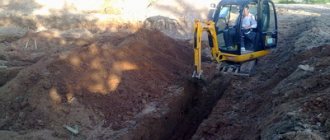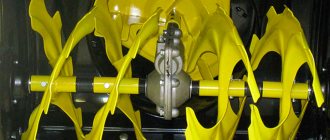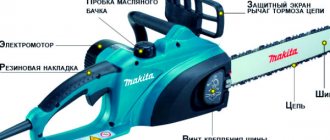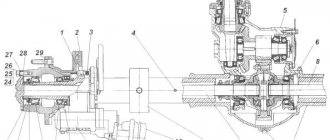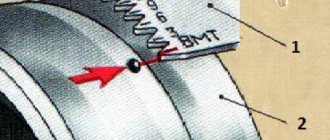Just as baking a cake begins with kneading the dough into layers, so construction always begins with the development of soil. And to be more precise, from the development of pits for the foundation.
Excavation of a pit using an excavator
To perform this work, excavators are used - special machines that are capable of quickly excavating soil in huge volumes. Without their ability to dig quickly and efficiently, the construction process could drag on for quite a long period.
How to properly dig a pit with an excavator?
An excavator is very often used for excavation work.
Let us remember that there is a wide range of similar equipment. Many specialized companies can provide very miniature models that can be used even on a small plot of land. At the same time, mechanization makes it possible to achieve incredibly high productivity in creating trenches and digging pits. In fact, there is nothing complicated about digging a pit; you just need to follow the technical rules. Of course, it is categorically not recommended to start the process until a full-fledged excavation plan has been developed. In addition, before starting to dig a pit, it is important to assess the qualitative composition of the soil. On the website https://strent.com.ua/razrabotka-kotlovanov you can get professional help regarding excavation work. But professionals do not always agree to participate in the project (an example is an object extremely remote from the city). In this case, you will have to rely only on your own strength and the recommendations listed below.
Technical performance
Calculating the performance of an excavator, which is called technical, differs in that the conditions in which the special equipment operates are taken into account. This means that the volume of the bucket, its filling coefficient, as well as the number of cycles are multiplied together, taking into account the operating conditions in a particular place, divided by the soil loosening coefficient. Naturally, all this is also multiplied by sixty to get the result in cubic meters per hour, which is a standard measure of the productivity of excavators specifically. But this does not take into account a very important parameter - the inevitable downtime that occurs during work. There are no conditions in which an excavator could work without the slightest interruption or hitch. This is why you need to calculate the operational productivity of an excavator per hour, since it is closest to reality.
Separate parts of the excavator operating cycle
To excavate, it is important to perform the following individual operations:
- cutting the soil with a bucket;
- rotation of the excavator platform;
- unloading soil from a bucket;
- reverse rotation to the surface being developed;
- setting the bucket to repeat the entire cycle.
As far as you can see, digging the soil itself takes quite a bit of time. More than 50% of the cycle is spent turning the excavator platform. To save time and fuel, it is recommended to perform several actions at the same time.
For example, the rotation of the platform and the detachable bucket for deepening can be performed in parallel. Moreover, placing the bucket on the ground is a separate issue. The point is that the boom should be extended by 70% (according to the technical regulations from the manufacturers of excavator equipment).
The ideal depth of the bucket is 100%. To save time on transporting soil, it is better to dump the bucket into the back of a truck. Moreover, carrying the bucket over the dump truck cab is strictly prohibited!
Management of domestic equipment
The control features of a Russian-assembled excavator will differ from imported machines in the presence of up to six hydraulic valves connected directly to the hydraulic cylinders of the excavator boom manipulator, as well as the bucket control mechanism.
Two pedals and a steering wheel for a pneumatic chassis or levers for a tracked vehicle will be responsible for the forward movement of the equipment. A course of theoretical training, as well as industrial practice, will be the answer to the question of how to properly work on a domestically assembled excavator.
Excavator tipping
A pit involves the excavation of fairly large volumes of soil. At the same time, the type of soil on the site can be different (combined). The generally accepted rule is to position the excavator from the edge of the pit to the value of its depth + 1 meter.
In this case, the drive wheels are located further, and the driven wheels closer to the edge.
If we are talking about developing a pit on marshy soil, it is extremely important to provide an additional platform on which special equipment will be installed. The platform area is provided with a margin (protrudes beyond the edge of the wheel/track by at least 1 meter).
See also:
- Do you know what fertile soil is and what are its characteristics?
- Learn about the principles of using aseptic primer - https://stroybud.com/chto-takoe-antisepticheskiy-grunt/
The video shows the process of developing a pit in Kaluga using a CAT excavator:
Digging trenches, pits, ponds
The first step is to clear the face (the area where the work is carried out, the excavator and additional equipment are located), from stumps, large stones, debris and any other unnecessary objects.
If it is necessary to transport soil over a long distance, the contents of the bucket are poured into the back of trucks. The optimal situation is when 3-7 full buckets fit in the back of a truck. The body is filled from the side or behind; moving the bucket over the cabin is prohibited. Filling should be done evenly, but the bucket should not be used to level the contents of the body.
The excavator must be placed at least one meter from the edge of the trench. The deeper the trench and the softer the soil, the further away the equipment is placed. A safe distance is recommended that exceeds the digging depth by one meter; the excavator is positioned so that the driving pair of wheels is further from the edge than the driven one.
Digging an artificial pond requires preliminary study of the soil and the depth of the immediate location of groundwater. It is extremely undesirable to use old equipment for such work; it will not be possible to save money this way, but it will be possible to incur a large number of expenses. The most correct and reasonable option is to use an excavator that can work over a long distance, this will save nerves and equipment.
When digging deep trenches and pits, the general rule is observed: the greater the depth, the flatter the slopes. If necessary, strengthen the walls.
If work is to be done in a swampy area, then take special shields with you, from which the work site should be assembled. The size of this area must exceed the length of the tracks themselves.
Compliance with work rules, service instructions and safety precautions makes it possible to avoid unexpected situations during work, material damage and damage to equipment. It will not be superfluous to draw up a contract for the performance of work in a certain volume.
Rules for developing soil in a pit or trench using an excavator
Digging a pit for the foundation of a house or trenches for a foundation is the initial stage in any construction, residential or industrial. The strength and durability of the entire future structure depends on how well it is made.
The process of digging a pit with an excavator
The excavation is developed in several stages and is not limited to directly digging a hole, as many people who are far from construction think. This is true for foundations of any type - slab, strip, block. For columnar and screw ones, excavation work using machinery is not carried out.
Standard performance
This type of performance almost completely corresponds to operational performance, but is only presented in the form of standards, that is, values that certain types of excavators must comply with. That is, this value is the amount of work that a specific machine must complete in a certain period of time, taking into account all operating conditions.
Preparation stages before pit development
Initially, a scheme and plan are developed. To draw up a pit design, several studies and examinations are carried out, in particular, they study the composition and density of the soil, calculate the static load on the foundation, and determine the presence and depth of groundwater.
The last indicator is especially important, since groundwater can often become an insurmountable obstacle to construction on a particular site. If the building must nevertheless be built here, then they resort to an expensive and technologically complex operation to drain the soil, and also during construction they install water drainage systems from the foundation.
Also, the composition of the soil and the depth of subsoil flows affect the angle of inclination of the side walls of the pit or trenches.
After the diagram and plan are drawn up, they are transferred directly to the area. This means that it is necessary to do a geodetic survey and, depending on its results, determine the dimensions of the future pit or trench and mark the area for it.
Marking the site before digging a pit
This same stage involves performing landscape adjustments to the soil: existing holes are filled in, hill ledges are leveled, unused structures are demolished, and vegetation is uprooted.
Before you start digging a foundation pit with an excavator or a trench for a water supply system, you need to make sure that there are no underground communication networks running in its place.
Key Variables
So, what do you need to consider to accurately calculate your excavator's performance? Naturally, you should understand that there are several types of performance that will have their own formula, which may involve other variables, so there is no universal set. But almost everywhere you can find an indicator of the capacity or volume of the bucket, which is the most important when performing the calculation. Well, other variables can be the number of cycles of repeated actions per unit of time, various coefficients if they are taken into account, for example, the soil loosening coefficient, as well as even the time spent on unloading, turning the bucket, and so on. In general, you will need to take into account many parameters so that any, even the operational performance of the excavator, which is the most popular type of data, can be calculated as accurately as possible.
Types of excavators
Most often, work to develop soil for a foundation, water supply or sewerage system is carried out using an excavator equipped with a front or backhoe. A straight shovel removes soil “away from itself”, and a reverse shovel – “toward itself”. A straight shovel works with rocks that are located above the parking level, a reverse shovel, respectively, with those that are located below.
Machines that have a straight shovel have higher efficiency, and this is achieved due to the strength of the buckets and the presence of a powerful hydraulic system. A straight shovel is used quite widely: digging pits and trenches, road construction work, stripping work.
The forward and reverse shovels have their own characteristics, as well as advantages and disadvantages.
Thus, equipment with a straight shovel can perform quite a large amount of work. Without such a mechanism, not a single construction enterprise will exist effectively.
One of the advantages of this technique is that the height of the ledge can be from 10 to 15 meters. Also, unlike backhoe excavators, it has one more group of hydraulic cylinders and a more complex technical content.
Excavator with straight shovel
A backhoe has a bucket volume of no more than 8 m3, which is not very convenient for performing large volumes of work. The backhoe and its operating pattern involve excavating soil only from a site that is below the level of the excavator. The backhoe has an undeniable advantage: ease of control and simplicity of design.
Wheel excavator
To carry out work involving deep digging and stripping operations, a rotary excavator is often used. Such equipment moves on its own, the work is performed continuously.
Scheme of operation of a rotary excavator: buckets mounted on a rotary wheel extract soil or rock. Since the buckets can rotate around their axis, they tend to fill completely.
The rotary excavator works perfectly at any temperature; its performance does not decrease at all, both at low and high temperatures. They can withstand the highest loads and operate continuously.
In addition to being able to dig pits, a bucket wheel excavator is capable of transporting and loading excavated soil into vehicles.
The rotary excavator is unloaded in two ways: gravitational and inertial. In the first case, the operation is carried out due to the acting forces of the rock when it is in the unloading zone, in the upper part of the rotor.
In the second - due to the influence of centrifugal forces acting on the rock. The excavated soil or rock is unloaded onto a conveyor located on the side of the excavator. After this, the spent rock enters the vehicle.
How to properly dig a foundation pit for a house? (video)
The process of digging pits with an excavator
Digging pits for construction or trenches for water supply does not seem to be quite complicated - the process diagram is simple, but it is imperative to follow all the stages. The efficiency of work depends not only on one excavator; many related equipment are involved in the process. If necessary, it is necessary to organize the removal of soil from the construction site, as well as strengthen the walls of the pit.
If you connect all the stages, you get the following diagram:
- Geological examination of soil, groundwater, selection of appropriate equipment.
- Analysis of the site for the presence of utility networks: underground water supply, gas pipeline, sewer system. If there are any, then organize their circuit around the construction site.
- Beginning of soil development on one side.
- Sequential removal of layers.
- Completion of earthworks.
- Strengthening or modifying the walls of the pit.
The scheme of work is quite simple, especially since the entire sequence of stages is controlled by surveyors.
The process of digging a pit with an excavator
Theoretical performance
It's no secret that the operational performance of an excavator is the most important type, since it is as close as possible to real calculations. But we will talk about it later, since it can be classified as a practical type. To begin with, it is better to pay attention to theory, namely theoretical performance, which is also called constructive. With its help, you can calculate the amount of work that an excavator can complete in an hour without interruptions. To do this, the total capacity of the bucket is multiplied by the number of cycles performed by the machine, and also by 60 to find out the result. It will be expressed in cubic meters per hour. This is exactly how the performance of an excavator is calculated on paper, but everyone knows perfectly well that ideal conditions do not exist, so for a more practical approach there are other formulas
My and your recommendations for digging a trench for water supply
I’m struggling with my mega-project; I’m digging a 120-meter trench for a water supply system, because the terrain does not allow sealing the well, and drilling a well is expensive and risky.
The pipe will go to the 32nd HDPE (probably), and since the pump is an ejector, there will also be a pipe that will drive water back to the well, into the ejector, here the pipe will be at 25. But that’s not about that now.
It would seem like a stupid thing to dig a trench, but no matter, without experience and some knowledge you will be digging it forever. Here I am sharing the information as I dig it. You can add something of your own, I will be glad to have interesting thoughts on making digging easier (from super-shovels to super-machines).
The tools include a strong bayonet shovel and a strong shovel, and in general, everything should be strong, but light!
